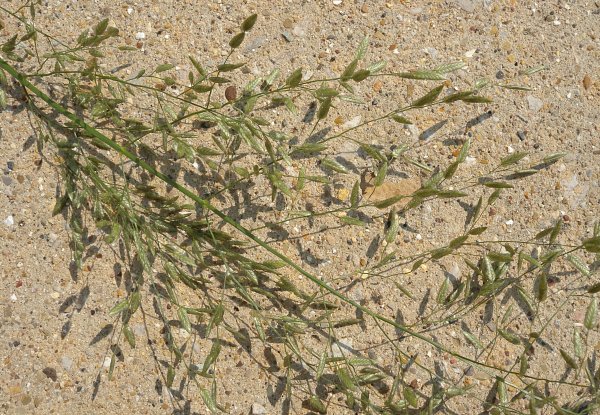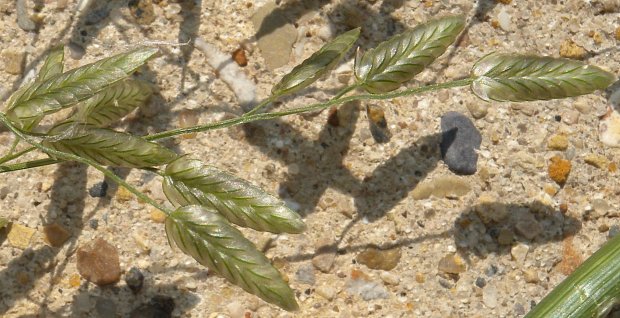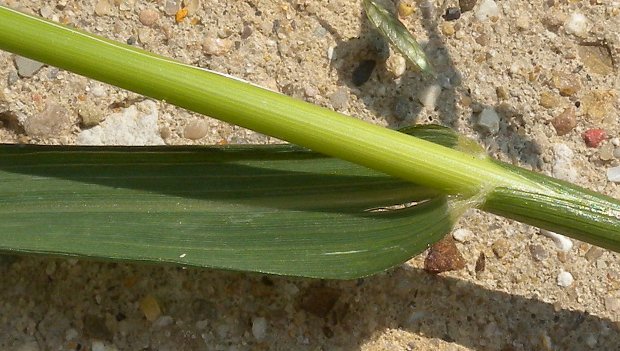
The pedicels of spikelets are up to 10 mm. long and divergent. The peduncle of the inflorescence is up to 6" long, medium green and glabrous. The rachis of the inflorescence is also green and glabrous, except at the bases of the primary lateral branches, where it has small tufts of hairs. The branches and pedicels of the inflorescence are medium green, wiry, and slightly scabrous. The spikelets are 5-20 mm. long, 2-3 mm. across, and compressed (somewhat flattened); they are whitish green or grayish green while immature, becoming light tan at maturity. Each spikelet has a pair of glumes at the bottom and 2 ranks of 8-40 overlapping lemmas above. The glumes are 1.5-2 mm. long, membranous, lanceolate, and keeled; they are green-veined along their keels and sometimes along their two sides. The lemmas are 2-3 mm. long, membranous, lanceolate-ovate, and keeled; they are green-veined along their keels and conspicuously green-veined along their two sides. The anthers of the florets are up to 0.5 mm. long. The blooming period occurs from mid-summer to early autumn, lasting about 1-2 weeks for individual plants. The perfect florets of the lemmas are cross-pollinated by wind. Afterwards, the florets are replaced by tiny grains; mature spikelets disarticulate above the glumes. Individual grains are about 0.5 mm. long, ovoid-globoid in shape, and dark brown or reddish brown. The root system consists of a tuft of fibrous roots. This grass reproduces by reseeding itself.

Cultivation: This grass prefers full sun, mesic to dry conditions, and barren or exposed soil where competition from other ground vegetation is reduced. It is often found in gravelly or sandy soil, but also occurs in more fertile soil. Most growth and development occurs during the summer. Because of its C4 metabolism, this grass is highly resistant to hot weather and drought. It does not tolerate regular mowing.
Range & Habitat: Stink Grass occurs in every county of Illinois, where it is fairly common (see Distribution Map). It was introduced accidentally into North America from Eurasia. Habitats include cropland, abandoned fields, upland pastures, sandy roadsides, gravelly areas along railroads, construction sites, mined land, gardens, and waste areas. Sunny habitats with a history of disturbance are preferred.

Faunal Associations: Insects that are known to feed on Stink Grass (Eragrostis cilianensis) include the Elm Cockscomb Aphid (Colopha ulmicola), Migratory Grasshopper (Melanoplus sanguinipes), and Pasture Grasshopper (Orphuella speciosa); see Middleton (1878) and a handbook of the Wyoming Agr. Exp. Sta. (1994). More broadly, other insects that use love grasses (Eragrostis spp.) as host plants include larvae of the Grass Sheath Miner (Cerodontha dorsalis), Love Grass Borer (Eurytomocharis eragrostidis), and Zabulon Skipper (Poanes zabulon); see Spencer & Steyskal (1986), Felt (1917), and Bouseman et al. (2006). The foliage of Stink Grass is usually avoided by mammalian herbivores as a source of food, including domesticated livestock (Georgia, 1913).
Photographic Location: The specimen plant was collected from the webmaster's wildflower garden in Urbana, Illinois. It was moved and photographed on a sidewalk.

Comments: Stink Grass (Eragrostis cilianensis) is rather similar in appearance to other grass species in its genus, which are collectively referred to as 'love grasses.' It can be distinguished from these other species by the greater abundance of lemmas in its spikelets (8-40), the presence of glandular droplets on the margins of its leaf blades, the presence of glandular droplets along the keels of its lemmas, and the stinky odor of its foliage. Stink Grass closely resembles Lesser Love Grass (Eragrostis minor) in many ways, except the former grass tends to be more robust in size and it tends to have more lemmas in its spikelets. However, a depauperate specimen of Stink Grass can be easily confused with a typical specimen of Lesser Love Grass because there is some overlap in their characteristics. Overall, wildlife use Stink Grass to only a limited extent in Illinois and surrounding areas of the Midwest.